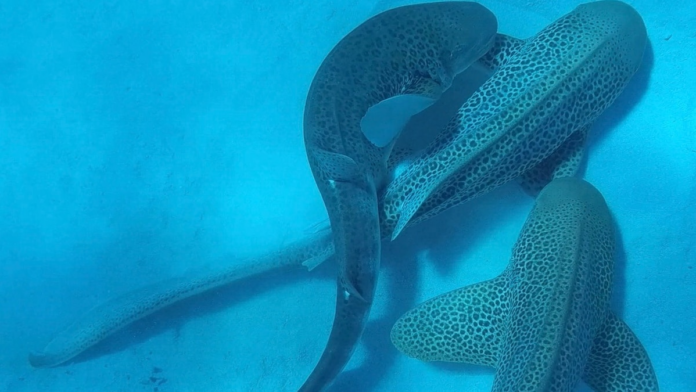Few shark species have ever been caught mating on camera. So when marine biologist Hugo Lassauce stumbled upon a trio of Indo-Pacific leopard sharks copulating in quick succession, he knew he had the opportunity to document something extraordinary.
Most shark mating involve violent frenzies where males bite females and jockey each other for prime positions. But Lassauce, a researcher at Australia’s University of the Sunshine Coast, observed relatively calm, gentle interactions among three Indo-Pacific leopard sharks off the coast of New Caledonia’s main island in the South Pacific.
Many previously seen shark mating encounters involved violent frenzies where males bite females and jockey each other for prime positions. But Lassauce, a researcher at Australia’s University of the Sunshine Coast, observed comparatively relatively calm, gentle interactions between three leopard sharks off the coast of New Caledonia’s main island in the South Pacific.
This particular shark species, also known as zebra sharks, had never been filmed having sex before, and Lassauce’s GoPro battery charge was low, so the pressure was on. “I was so stressed because I wanted to record it in the best way I could. I wanted to get all the biological details,” Lassauce says.
He watched, heart racing, as the female cruised by with a male hanging off each fin. The males then took turns mating her for a total of 110 seconds, which is actually pretty good for a shark, before collapsing from exhaustion.
“The second it was over and the female swam away, my GoPro battery died,” Lassauce says.
A big mystery
The sex lives of these sharks are something scientists like Lassauce have long wanted to understand. “It’s been a big mystery,” he says. “These are sharks you can see at recreational dive sites where people have been diving for years, yet no one had ever recorded [them having sex].”
Although abundant in this location, these sharks are in danger of disappearing. Thanks to overfishing and habitat loss, their numbers have declined by more than 50 percent over the past 50 years.
Lassauce says the footage he collected may be of use to scientists trying to breed the imperiled sharks in captivity. “We know now that the females are not just mating with one male,” he said.
(This might be the first newborn great white shark ever recorded)
“If we want to give this endangered species a real shot at recovery, we have to safeguard the places where the next generation of sharks begins,” says Melissa Cristina Márquez, an independent shark scientist who was not involved with the new paper.
“Understanding these private moments helps us not only learn more about their reproductive strategies but also highlights which habitats need protection,” Márquez added.
While this new footage has helped scientists like Lassauce determine where these sharks are breeding, where these sharks lay their eggs, and where their young spend their first years remains a mystery. Figuring that out, Lassauce says, will help conservationists protect the sharks when they are most vulnerable.
Until then, Lassauce and his colleagues from the Aquarium des Lagons will continue creeping on these sharks in the hopes of securing their future.




